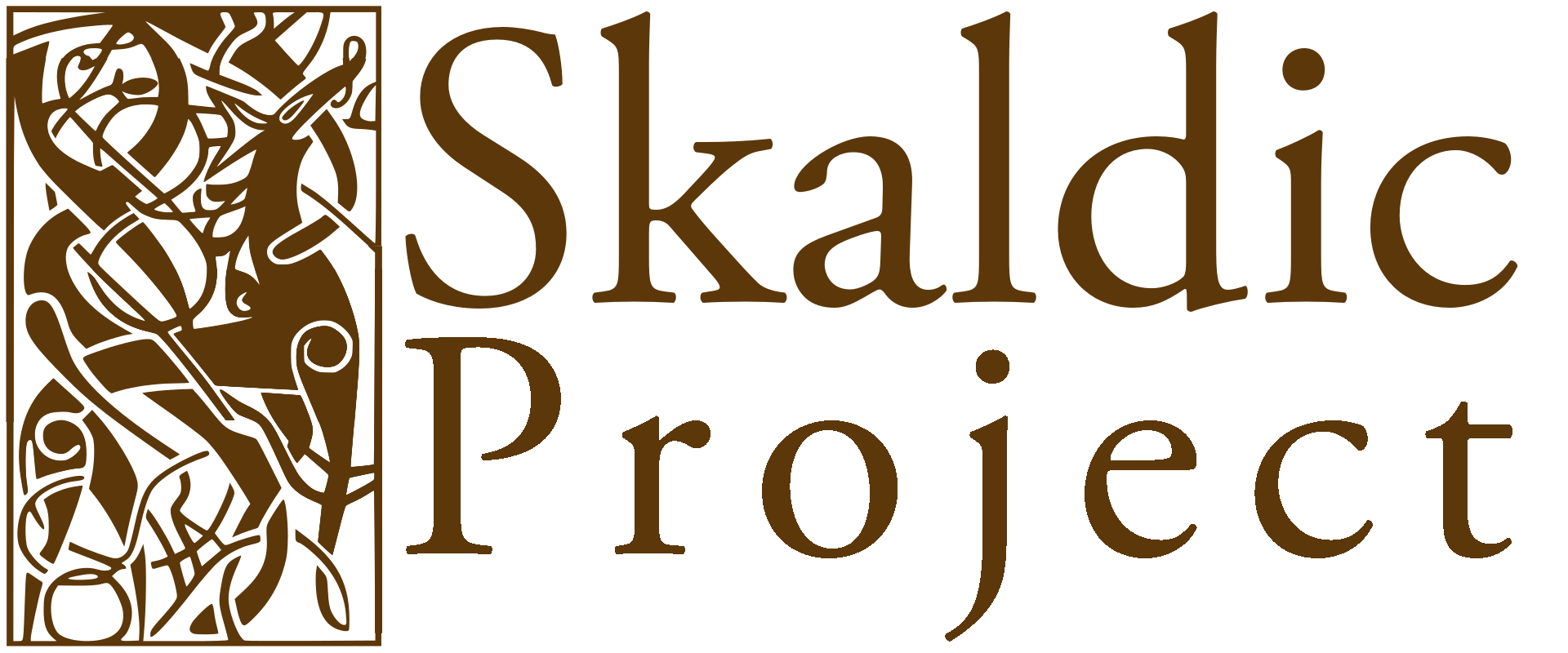Anon (Vǫls) 1VIII (Vǫls 1)
Margaret Clunies Ross (ed.) 2017, ‘Vǫlsunga saga 1 (Anonymous Lausavísur, Lausavísur from Vǫlsunga saga 1)’ in Margaret Clunies Ross (ed.), Poetry in fornaldarsögur. Skaldic Poetry of the Scandinavian Middle Ages 8. Turnhout: Brepols, p. 792.
Ristu ‘They cut’
(not checked:)
2. rista (verb): carve
af ‘with’
(not checked:)
af (prep.): from
magni ‘strength’
(not checked:)
magn (noun n.; °-s): strength
mikla ‘the huge’
(not checked:)
mikill (adj.; °mikinn): great, large
hellu ‘stone slab’
(not checked:)
1. hella (noun f.; °-u; -ur): cave, slab
Sigmundr ‘Sigmundr’
(not checked:)
Sigmundr (noun m.): Sigmundr
notes
[3, 4] Sigmundr … Sinfjötli ‘Sigmundr … Sinfjǫtli’: According to Vǫls, Sigmundr is the son of Vǫlsungr, descended directly via his father, Rerir, and grandfather, Sigi, from Óðinn. He is himself the father of the hero Sigurðr. Sigmundr and his son Sinfjǫtli are mentioned together in the C10th Anon Eirm 5/1I, as welcoming King Eiríkr blóðøx ‘Blood-axe’ to Valhǫll and are also paired, as uncle and nephew, in the Old English Beowulf ll. 874-900, where their exploits in the forest are mentioned. It is uncertain whether the Anglo-Saxon poet knew the tradition of the incestuous birth of Sinfjǫtli (OE Fitela).
hjörvi ‘with his sword’
(not checked:)
hjǫrr (noun m.): sword
notes
[3] hjörvi ‘with his sword’: According to Vǫls ch. 3, Sigmundr obtains his sword by drawing it out of the trunk of an apple tree growing in the middle of his father’s hall. Like King Arthur and his acquisition of the sword Excalibur, only Sigmundr can withdraw the sword from the tree-trunk into which it has been plunged by Óðinn.
ok ‘and’
(not checked:)
3. ok (conj.): and, but; also
Sinfjötli ‘Sinfjǫtli’
(not checked:)
Sinfjǫtli (noun m.): Sinfjǫtli
notes
[3, 4] Sigmundr … Sinfjötli ‘Sigmundr … Sinfjǫtli’: According to Vǫls, Sigmundr is the son of Vǫlsungr, descended directly via his father, Rerir, and grandfather, Sigi, from Óðinn. He is himself the father of the hero Sigurðr. Sigmundr and his son Sinfjǫtli are mentioned together in the C10th Anon Eirm 5/1I, as welcoming King Eiríkr blóðøx ‘Blood-axe’ to Valhǫll and are also paired, as uncle and nephew, in the Old English Beowulf ll. 874-900, where their exploits in the forest are mentioned. It is uncertain whether the Anglo-Saxon poet knew the tradition of the incestuous birth of Sinfjǫtli (OE Fitela).
Interactive view: tap on words in the text for notes and glosses
Sigmundr and his son Sinfjǫtli, the latter begotten incestuously with Sigmundr’s sister Signý, live in the forest while contriving vengeance for the death of their father Vǫlsungr at the hands of Signý’s husband Siggeirr. Siggeirr has the two Volsungs imprisoned in a huge burial-mound made of stones and turf, thinking to starve them to death. Signý contrives to send them food in the shape of a piece of pork into which Sigmundr’s sword has been thrust. Stanza 1 describes how Sigmundr and Sinfjǫtli use Sigmundr’s sword to saw through the huge stone slab that blocked the entrance to the mound. It is introduced with the words sem kveðit er ‘as it is told’.
The source of these lines is unknown, and the introductory formula, like many in Vǫls, is imprecise. ÍF Edd. does not include these lines.
Stanza/chapter/text segment
Use the buttons at the top of the page to navigate between stanzas in a poem.
Information tab
- text: if the stanza has been published, the edited text of the stanza and translation are here; if it hasn't been published an old edition (usually Skj) is given for reference
- sources: a list of the manuscripts or inscriptions containing this stanza, with page and line references and links (eye button) to images where available, and transcription where available
- readings: a list of variant manuscript readings of words in the main text
- editions and texts: a list of editions of the stanza with links to the bibliography; and a list of prose works in which the stanza occurs, allowing you to navigate within the prose context
- notes and context: notes not linked to individual words are given here, along with the account of the prose context for the stanza, where relevant
Interactive tab
The text and translation are given here, with buttons to toggle whether the text is shown in the verse order or prose word order. Clicking on indiviudal words gives dictionary links, variant readings, kennings and notes, where relevant.
Full text tab
This is the text of the edition in a similar format to how the edition appears in the printed volumes.
Chapter/text segment
This view is also used for chapters and other text segments. Not all the headings shown are relevant to such sections.
